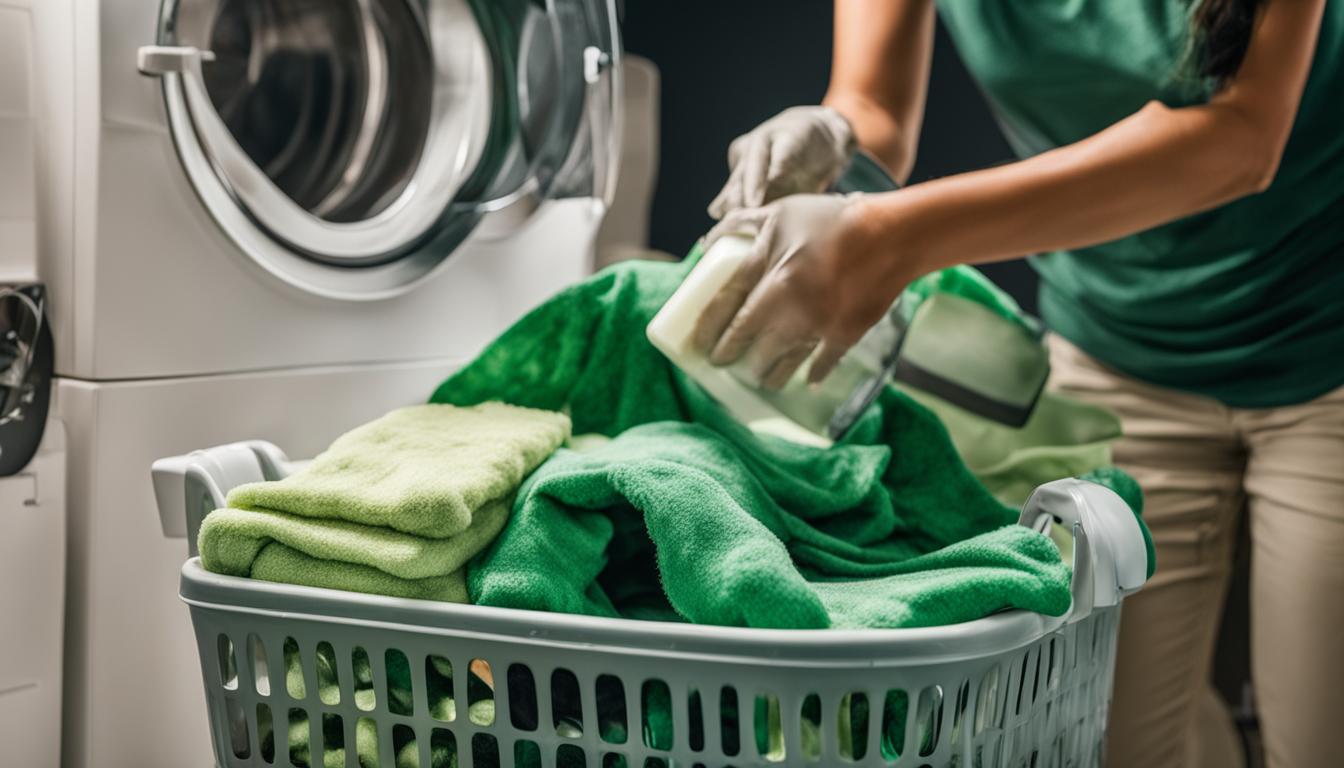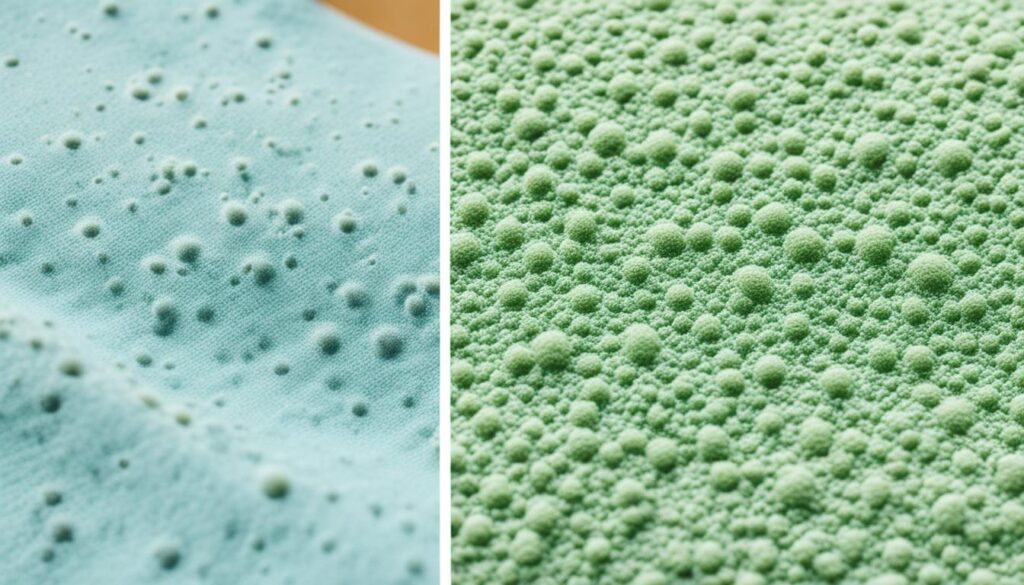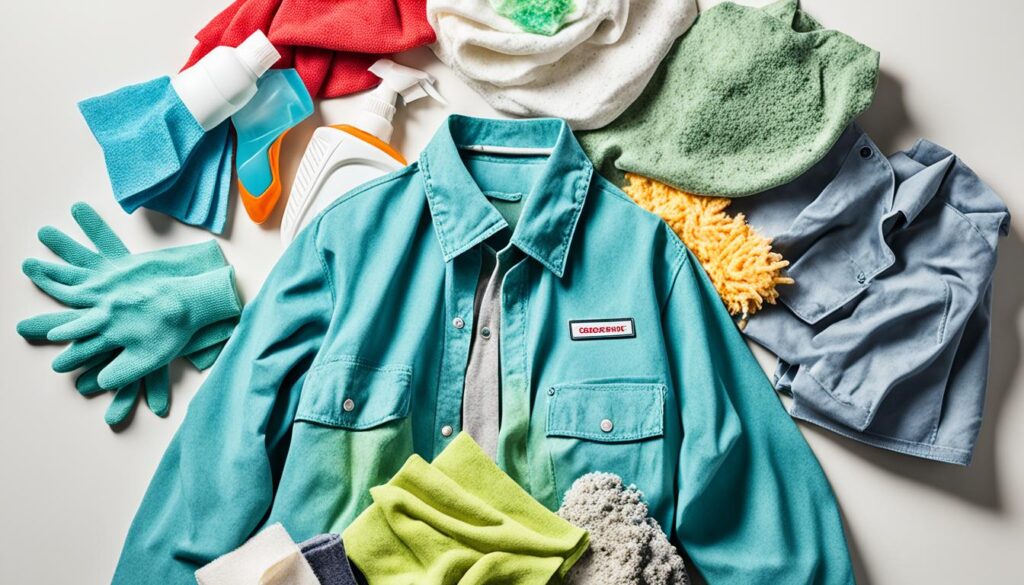
Remove Mold from Clothes: Effective Cleaning Guide
In this comprehensive guide, we will provide you with proven tips and techniques on how to effectively remove mold from clothes. Don’t let mold stains ruin your favorite garments. By following the steps outlined in this article, you can restore your clothes to their original freshness and ensure they are mold-free.
Key Takeaways:
- Removing mold from clothes is essential to maintain their cleanliness and prevent health hazards.
- Proper assessment of the mold situation on clothes is crucial before starting the cleaning process.
- Preparing clothes for mold removal involves taking necessary safety precautions and gathering the right supplies.
- There are various methods and techniques to remove mold stains from different fabric types.
- After removing mold stains, proper laundering techniques should be used to eliminate any remaining spores and odors.
Understanding Mold Growth on Clothes
Mold growth on clothes can be a frustrating and unsightly problem. It can occur due to various factors, such as high humidity levels, poor ventilation, or even a mold-infested wardrobe. Understanding the causes of mold growth is crucial in preventing mold from ruining your favorite garments. In this section, we will explore the common reasons why mold grows on clothes and provide you with effective strategies to prevent it.
Common Causes of Mold Growth on Clothes
Mold spores are present everywhere, including in the air we breathe. When these spores land on damp fabric surfaces, they can quickly grow and multiply, resulting in mold growth. Here are some common causes of mold growth on clothes:
- High humidity levels: Excess moisture in the air, especially in humid climates or during periods of rainfall, can create a favorable environment for mold to thrive.
- Poor ventilation: Lack of proper airflow in your wardrobe or storage area can contribute to moisture buildup, making it easier for mold to grow on clothes.
- Water damage: If your clothes have been exposed to water damage, such as from a leak or flood, they are more susceptible to mold growth if not dried and cleaned promptly.
Preventing Mold on Clothes
Prevention is key when it comes to dealing with mold on clothes. By taking proactive measures, you can significantly reduce the risk of mold growth and protect your wardrobe. Here are some steps you can take to prevent mold on clothes:
- Ensure proper ventilation: Allow air to circulate in your wardrobe by keeping doors slightly open or using a dehumidifier to regulate humidity levels.
- Keep clothes dry: Thoroughly dry your clothes before storing them. Avoid packing damp or wet items as it creates a breeding ground for mold.
- Maintain a clean wardrobe: Regularly clean and declutter your wardrobe to prevent mold spores from settling on fabric surfaces. Wipe down shelves and surfaces with a solution of vinegar and water, known for its mold-fighting properties.
- Use moisture absorbers: Place moisture-absorbing products, like silica gel packets or activated charcoal, in your wardrobe to help absorb excess moisture.
It’s essential to remember that prevention is always better than cure. By implementing these preventive measures, you can significantly reduce the chances of mold growth on your clothes.
In the next section, we will discuss how to effectively clean moldy clothes and restore them to their original state.
Assessing the Mold Situation on Clothes
Before you can effectively remove mold from clothes, it is essential to assess the severity of the situation. By identifying mold stains and understanding the type of fabric and level of mold growth, you can determine the best approach for mold removal.
When assessing the mold situation on clothes, look for signs of mildew stains. Mildew presents itself as black, gray, or green patches on fabric. It thrives in damp and humid environments, making it common on clothes stored in poorly ventilated areas.
When handling delicate fabrics, such as silk or wool, it may be necessary to consult a professional dry cleaner for mildew stain removal. They possess the expertise and specialized equipment to effectively treat and remove mold from these sensitive materials.
Tip:
Before proceeding, always check the care instructions on the garment label. Some fabrics may have specific cleaning requirements that should be followed to ensure optimal results.
To determine the extent of mold growth, inspect the affected garments closely. Look for indications of mold spores such as a musty odor or discoloration on the fabric. Pay attention to hidden areas like pockets, folds, or hems that may harbor mold growth.
How to Identify Mold Stains:
- Examine the garment for visible discoloration, such as dark spots or patches.
- Feel the fabric for a damp or sticky texture, which could indicate the presence of mold.
- Sniff the garment for any unpleasant musty or moldy odors.
Once you have assessed the mold situation on your clothes, you can proceed with confidence to the next step of the mold removal process. Remember, prompt action is crucial to prevent further damage to your garments and ensure successful mold removal.

Preparing Clothes for Mold Removal
Before you begin the mold removal process, it is crucial to properly prepare your clothes to ensure successful cleaning. Taking the necessary steps to prepare your garments will not only facilitate effective mold and mildew removal but also ensure your safety during the process. Follow these step-by-step instructions to prepare your clothes for mold removal:
- Gather the necessary supplies: Before you start, make sure you have the following items on hand:
- Disposable gloves
- Protective eyewear
- N95 respirator mask
- Plastic bags or bins for storing contaminated items
- Choose a well-ventilated area: Find a spacious and well-ventilated area in your home, such as a garage or outdoor space, to perform the mold removal process. Adequate ventilation is essential to minimize the inhalation of mold spores.
- Sort and remove heavily contaminated items: Inspect your clothes and separate heavily contaminated items from those with minimal mold growth. If clothing items are heavily infested with mold, it may be best to dispose of them to prevent further contamination and potential health hazards. Place these heavily contaminated items in plastic bags or bins for safe disposal.
- Protect surrounding surfaces: Cover nearby surfaces, such as tables, countertops, or floors, with plastic sheets or old newspapers to prevent any potential transfer of mold spores or cleaning product residues.
- Pre-treat stains (if applicable): If there are visible mold stains on your clothes, you can pre-treat them with a mild detergent or a mold and mildew stain remover. Follow the instructions provided with the stain remover product for best results.

Proper preparation is the key to successful mold removal from clothes. By following these steps and ensuring the appropriate safety measures, you can effectively clean your moldy garments and restore them to a fresh and odor-free state.
Removing Mold Stains from Clothes
Now that your clothes are ready for cleaning, it’s time to remove the mold stains. Mold can leave unsightly marks on different fabric types, but with the right methods and techniques, you can effectively eliminate them. Here are some mold removal tips to restore your garments back to their former glory:
- Vinegar Solution: Create a mixture of equal parts white vinegar and water. Apply the solution to the mold-stained area using a clean cloth or sponge. Gently blot the stain until it disappears. Rinse the fabric thoroughly to remove any vinegar residue before washing.
- Baking Soda Paste: Make a paste by combining baking soda and water. Spread the paste over the mold stains and allow it to sit for about 30 minutes. Scrub the fabric with a soft brush or toothbrush to lift the stains. Rinse the garment with water and proceed to wash it as usual.
- Lemon Juice and Salt: Squeeze fresh lemon juice directly onto the mold stains and sprinkle salt over them. Rub the fabric together to create a mild abrasive action. Let the garment sit in direct sunlight for a few hours, and then wash it with laundry detergent.
In addition to these methods, it’s important to note that hot water can set mold stains, so always use cold or lukewarm water when treating them. For delicate fabrics, it’s recommended to consult a professional cleaner to ensure gentle mold removal.
“By using natural ingredients like vinegar, baking soda, and lemon juice, you can safely and effectively remove mold stains from different fabric types.”
Remember to inspect the fabric after the mold removal process. If any mold residue remains, repeat the cleaning steps or consider seeking professional assistance. Keep in mind that prompt mold removal is crucial to prevent further damage and potential health risks.
Laundering Moldy Clothes
After removing mold stains, it’s crucial to launder the clothes properly to eliminate any remaining mold spores and odors. This section will guide you on how to wash moldy clothes using the appropriate laundry techniques and products to ensure a thorough cleaning.
1. Sort and Isolate
The first step in laundering moldy clothes is to separate them from your regular laundry. This helps prevent the spread of mold spores to unaffected garments. Place the moldy clothes in a separate container, such as a plastic bag, for easy transport to the washing machine.
2. Choose the Right Detergent
Select a detergent that is effective in removing mold and mildew stains. Look for products specifically designed for mold removal or those that contain ingredients like hydrogen peroxide or bleach. These powerful cleaners will help break down mold and eliminate odors.
3. Use Hot Water
Hot water is more effective in killing mold spores and removing stubborn stains. Check the care label on your clothing to ensure they can be washed in hot water. If the garment cannot tolerate hot water, use the warmest temperature recommended by the label.
4. Add Vinegar
Vinegar is a natural and effective mold remover. Add one cup of distilled white vinegar to the washing machine along with your chosen detergent. The acetic acid in vinegar breaks down mold and helps to neutralize odors.
5. Extra Rinse Cycle
To ensure all traces of mold and detergent are removed from your clothes, run an extra rinse cycle. This will help flush out any remaining mold spores, detergent residue, and vinegar smell.
6. Hang to Dry in the Sun
After washing, it’s important to dry the clothes thoroughly to prevent the growth of mold. Hang the clothes outside in direct sunlight, as the UV rays help kill any remaining mold spores. The fresh air will also eliminate any lingering odors.
| Laundry Mold Removal Tips |
|---|
| Avoid overloading the washing machine to ensure proper agitation and cleaning. |
| Consider using a pre-soak cycle for heavily mold-infested clothes. |
| Repeat the washing process if any mold stains or odors persist. |
| Regularly clean and disinfect your washing machine to prevent mold growth. |
Drying and Inspecting Clothes
Once the clothes have been properly cleaned, the next crucial step is to ensure they are thoroughly dried and inspected. This will help prevent any leftover moisture or mold spores from causing a recurrence of mold growth. Follow these mold removal tips to effectively dry and inspect your garments:
- Drying: Hang the clothes in a well-ventilated area, preferably outdoors, where they can receive adequate airflow. Avoid drying them in damp or humid environments, as this can promote mold growth. Ensure that each garment is spread out and not crammed together, allowing air to circulate freely around them.
- Inspecting: Once the clothes are dry, carefully examine each garment for any signs of remaining mold stains or musty odors. Focus on areas that are prone to mold growth, such as folds, seams, and cuffs. If any mold stains or odors are detected, repeat the cleaning process to remove them completely.
If you come across mold stains or detect a musty odor during the inspection, don’t hesitate to take immediate action to prevent further mold damage. By following these mold removal tips and maintaining a vigilant approach to drying and inspecting your clothes, you can effectively prevent mold from recurring and keep your garments fresh and mold-free.
Expert Tip:
To further prevent mold growth, add moisture-absorbing products, such as silica gel packs or activated charcoal, to your storage space or wardrobe. These products can help maintain low humidity levels and reduce the risk of mold development on your clothes.
| Mold Removal Tips | Prevent Mold on Clothes |
|---|---|
| Properly dry clothes in a well-ventilated area | Store clothes in a well-ventilated wardrobe or closet |
| Inspect garments for mold stains and musty odors | Avoid storing damp clothes or wet items in the wardrobe |
| Repeat the cleaning process if mold stains or odors are detected | Use moisture-absorbing products like silica gel or activated charcoal |
Conclusion
In conclusion, this comprehensive guide has provided you with effective methods for removing mold from clothes and preventing its recurrence.
By following the step-by-step instructions and utilizing the appropriate cleaning techniques, you can ensure that your garments are mold-free and fresh once again.
If you encounter a severe mold situation or require professional assessment, prevention, and remediation services, don’t hesitate to reach out to Fix Mold Miami. Their team of experts is equipped to handle mold-related issues and can be contacted at 305-465-6653.




